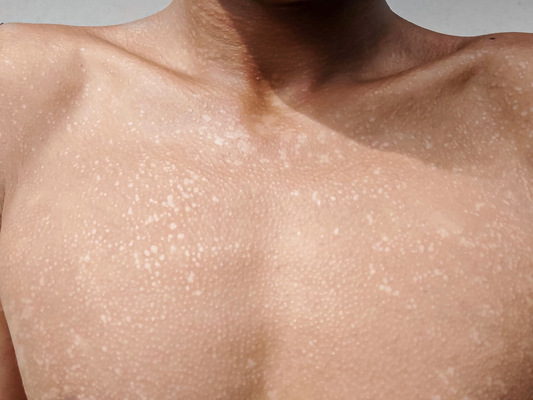What Causes White Spots on Skin?
 White spots on skin can be concerning, especially if they appear suddenly or seem to spread. These spots may vary in size, shape and severity, depending on the underlying cause. Understanding what causes white spots on skin can help you identify whether they are harmless or require professional attention.
White spots on skin can be concerning, especially if they appear suddenly or seem to spread. These spots may vary in size, shape and severity, depending on the underlying cause. Understanding what causes white spots on skin can help you identify whether they are harmless or require professional attention.
What Are White Spots on Skin?
White spots on skin, also known as hypopigmentation, occur when the skin loses melanin, the pigment responsible for skin color. These spots can appear anywhere on the body and may range from tiny white spots to larger patches. While white spots on skin are generally harmless, they can sometimes signal an underlying health condition.
Common Causes of White Spots on Skin
White spots on skin can arise from various conditions, ranging from fungal infections to chronic skin disorders. Below, we explore some of the most common causes of white skin spots, their symptoms and available treatments.
Tinea Versicolor
One of the most frequent causes of white spots on skin is tinea versicolor, a fungal infection caused by the overgrowth of yeast that naturally lives on the skin. This condition is more common in warm, humid climates and can result in tiny white spots on skin, as well as patches that appear lighter or darker than the surrounding skin.
- Symptoms: Small, scaly, white or discolored patches, often on the chest, back and shoulders.
- Treatment: Antifungal creams, shampoos or oral medications prescribed by a dermatology provider.
Vitiligo
Vitiligo is a condition where the immune system attacks the melanocytes, leading to the loss of skin pigmentation. It can cause white skin spots of varying sizes and shapes, often appearing symmetrically on the body.
- Symptoms: Smooth, white patches on the skin, often around the face, hands and feet.
- Treatment: While there is no cure, treatments such as topical steroids, phototherapy or skin grafts may help restore pigmentation.
Idiopathic Guttate Hypomelanosis (White Sun Spots)
White sun spots on skin, also known as idiopathic guttate hypomelanosis, are small, flat white spots caused by prolonged sun exposure. These spots are harmless and typically appear on areas of the body that receive the most sun exposure, such as the arms and legs.
- Symptoms: Tiny, round, white spots on sun-exposed skin.
- Treatment: Prevention through sunscreen use is key. Treatments are not very effective once these have formed, but sometimes there is improvement with cryotherapy or laser therapy.
Pityriasis Alba
Pityriasis alba is a common skin condition in children and adolescents. It causes white patches, typically on the face, and is linked to mild eczema.
- Symptoms: Round or oval, slightly scaly white patches on the face or upper body.
- Treatment: Moisturizers and mild steroid creams can help improve the appearance of the spots.
Eczema and Psoriasis
Chronic skin conditions like eczema and psoriasis can sometimes cause white patches due to skin inflammation and healing processes.
- Symptoms: Dry, itchy, scaly patches that may become lighter as they heal.
- Treatment: Topical treatments, phototherapy or prescription medications to manage inflammation.
Less Common Causes of White Spots on Skin
Less common causes of white spots include:
- Lichen Sclerosus, a rare condition that causes thin, white patches on the skin, typically in the genital area. It can lead to discomfort and scarring if untreated.
- Leukoderma, also known as chemical leukoderma. It occurs after exposure to certain chemicals, leading to white patches on the skin.
- Post-Inflammatory Hypopigmentation can sometimes appear as white spots after an injury, rash or burn. This loss of pigmentation can be temporary or permanent and is due to the inflammation and scarring.
- Congenital Conditions, those people are born with like piebaldism or albinism, result in white patches or complete loss of pigmentation.
How to Prevent White Spots on Skin
While not all causes of white skin spots can be prevented, certain measures can reduce the risk:
- Use Sunscreen: Protect your skin from harmful UV rays to prevent white sun spots and other sun-related damage.
- Maintain Skin Hygiene: Regularly cleanse your skin to prevent fungal infections like tinea versicolor.
- Moisturize: Keeping your skin hydrated can help prevent conditions like pityriasis alba and eczema.
When to See a Dermatologist for White Spots
White spots on skin are often harmless, but they can sometimes signal an underlying health condition that requires medical attention. Consider consulting a dermatology provider if you notice the following:
- Persistent White Spots: Spots that do not fade or worsen over time.
- Spreading or Growing Spots: White skin spots that spread to other areas of the body.
- Accompanying Symptoms: Itching, pain, redness or scaling.
- Emotional Distress: If white spots on skin cause self-consciousness or anxiety.
A dermatology specialist can assess your skin, provide an accurate diagnosis and recommend effective treatments. Whether you’re dealing with tiny white spots on skin, white sun spots on skin or larger patches, seeking professional advice is the best way to ensure healthy, clear skin.
White Spot Treatment at Schweiger Dermatology Group
If you’re struggling with white spots on skin, the experts at Schweiger Dermatology Group are here to help. Our experienced dermatologists and dermatology specialists diagnose and treat a wide range of skin conditions. Book online or call 844-DERM-DOC to make an appointment.
